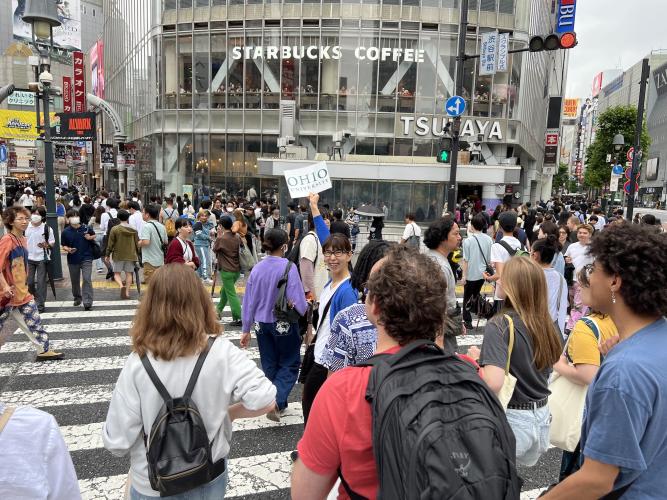
'Everything I would want to see and do and learn': Two weeks to explore culture and animation in Tokyo

The flight time alone—13 hours—tells you it’s a big trip, and maybe it’s even a once-in-a-lifetime opportunity. Factor in the jam-packed schedule of tea ceremonies, kabuki performances, Buddhist temples, anime museums and animation studios, and you start to understand just how impactful a study abroad program can be. Add one more thing: it’s capped off with a visit to Tokyo Disneyland. Now you see how Japan: Animation and Culture in Tokyo is a life-changing experience, and not just for animation majors.
Designed, researched and led by program directors Beth Novak, interim dean of the Honors Tutorial College, and Kate Raney, assistant professor and undergraduate coordinator for the School of Media Arts and Studies, the inaugural Japan: Animation and Culture in Tokyo study abroad program provided a variety of students immersive experiences in Japanese culture and animation.
“We had an interesting mix [of students],” Novak said of the participants, who boast various years, majors and levels of animation knowledge. “But I think the majority of the students actually just had a love for Japanese culture and wanted to experience it. So we actually had quite a few first-time animators in the class.”
Courtney Rather's animation project
One of the youngest students on the trip, Courtney Rather, only just completed her first year of college before seizing the opportunity to go on this study away experience. The media arts and studies—animation major heard about the program while touring OHIO; she said she was excited about it because she’d always wanted to travel to Japan.
“Once I became a freshman, I saw posters for it all around,” Rather said. “So I went ahead and applied. … For a minute there, I didn't think I was going to get in because I'm a freshman, I don't have a lot of animation experience [and] I've only really taken like these core classes.” Much to her surprise, Rather was accepted.
Meanwhile, Tevy Toleman, a senior studying integrated media, pursued this trip as a means to get outside of her comfort zone. She found the program on the Office of Global Opportunities website.
“It was crazy how perfect [the trip] was. It's everything I would want to see and do and learn,” Toleman said. “I was like, ‘I have to do this before I graduate.’’’
George Boyadijan's animation project
For George Boyadijan, a senior studying games and animation with a minor in Japanese, the trip provided the opportunity to practice the language with native speakers and to see locations featured in the shows and games he has watched and played.
“Anime is almost a culture; it’s got its own following, its own stylistic choices, its own characters and tropes,” Boyadijan says. Raney added that while anime in the U.S. can sometimes be seen as specifically targeting a certain age group, in Japan, it can apply to any animated program.
Anime is the Japanese word used to describe any cartoon or animation, regardless of its place of origin. However, outside Japan, anime describes all animation originating and produced in Japan, according to the Nashville Film Institute.
Raney noticed how often anime characters appeared during the trip. The characters were in advertisements, directions at shrines and at train stations. There was even a Nintendo Tokyo store and a Kirby Café, which featured the Nintendo character on its food and plates.
Such cultural exposure to character design was key for junior Mo Jeffries, who’s majoring in media arts and studies, minoring in art history and earning a Professional Deaf Resources Liaison Certificate.
“It’s very important to have a sense of different cultures and different people so that you can have a broad spectrum of characters [in your work],” Jeffries said. “Having a more in-depth exploration of other cultures helps broaden your own creative output.”
Mo Jeffries' animation project
During their cultural immersion in Japan, Novak and Raney asked students to complete discussion posts every few days, covering themes like neighborhood culture and traditional art. Following the trip, each student submitted a final animation project based on their individual experience.
Jeffries’ project focused on creating a character. With a love for racoons, she decided to develop her own version of the Japanese racoon dog, also known as a tanuki. Using frame-by-frame animation, Jeffries combined her visual diary of three-second videos filmed during the trip with the tanuki animations.
“You see them bowing with a kimono, or you see them in kind of a samurai outfit in front of the palace gate, you see them in the museum,” she says. “They go through a couple different spots, just kind of existing in the scene.”
The trip was filled with a variety of experiences, including visits to the Ghibli Museum, the Edo-Tokyo Open Air Architectural Museum and immersive art museum teamLab Planets. Raney said the Suginami Animation Museum brought her immense joy, even though it was small.
“The thing that was so sweet to me about [the Suginami Animation Museum] is, there was a room where [our students] could do animation, like hand-drawn animation,” she said. “They showed you the process, and you have the materials … just seeing our students sitting in the room and drawing, it was like, ‘Oh, I love this!’ It was so sweet, and so there were just a ton of great experiences.”
Many of the students spoke about how much gratitude they held for this experience abroad, each citing different favorite memories from the trip.
“If you're thinking about traveling, just go ahead and apply for it,” Rather said. “I almost didn’t, and I would have missed going to Japan.”
Novak and Raney plan to host the Japan: Animation and Culture in Tokyo trip biannually, with the next experience scheduled for summer 2025.
